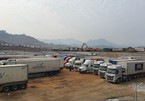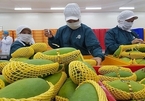For more than two months, the congestion of agricultural products at the Vietnamese-Chinese border gates in Quang Ninh and Lang Son provinces remains unresolved. The number of trucks carrying agricultural products waiting for customs clearance at these border gates can reach nearly 6,000 during peak hours.
The main cause of this unprecedented congestion is China's implementation of its "Zero Covid" strategy, strengthening epidemic control in border provinces. However, this is not the first time this situation has happened. Whenever it occurs, the price of agricultural products plummets and farm produce is left rotten on the field, or “rescue campaigns” for farmers have to be launched.
Huge market is getting picky
 |
|
At the border gates in Quang Ninh and Lang Son, trucks carrying agricultural products to China queue in long lines waiting for customs clearance. (Photo: Kien Trung)
|
With a population of 1.4 billion, China is an important market for Vietnamese agricultural products. However, this huge market is no longer easy. Instead of importing all kinds of agricultural products, since 2018, China has changed its rules.
Not only strengthening inspection and traceability of imported goods, Chinese companies demand that Vietnamese goods comply with the requirements of the Chinese customs agency on quarantine permits, origin, information of the packing factory, barcodes, and QR codes.
Mr. Huynh Tan Dat, Deputy Director of the Plant Protection Agency, said that China has changed many regulations on plant quarantine and food safety with imported goods. The country is tightening control over cross-border goods, especially small-scale trade, along with the requirements for negotiation for each type of product. In addition, China regulates imported products in the form of protocols and requires declarations about the growing area codes and packing facilities.
China's list of pests includes 500 species, including common ones sometimes on Vietnam's fresh fruit exports.
"China is no longer an easy market,” said Ngo Xuan Nam, Deputy Director of SPS Vietnam Office (Ministry of Agriculture and Rural Development). In 2021, China issued a total of 42 notices about changes in food hygiene and safety and animal and plant quarantine.
Most recently, the Chinese authorities issued GB 2763-2021 standards, stipulating 10,092 residue limits for 564 pesticides, on the list of 376 foods. Compared with the previous standard, the number of pesticides in the new standard increased by 81 types while the pesticide residue limit increased by 2,985 types, up 42%.
China also issued Orders 248, 249 for imported goods on food safety standards and growing areas. Produce entering China must meet safety standards and high-level criteria.
The increased income of the Chinese people has led to a change in consumption trends. More Chinese consumers are choosing high quality, guaranteed origin products.
At the same time, Vietnamese agricultural producers have kept the old production habits and are slow to change, so the export of agricultural products to China is decreasing gradually.
According to data from the Vietnamese Ministry of Agriculture and Rural Development, from 2011 to 2018, China was Vietnam's largest fruit and vegetable consumption market, accounting for 75% of Vietnam’s total exports of fruit and vegetables. In 2018 when China set many technical barriers, the export of fruits and vegetables to China was 2.58 billion USD, down 2.5% in value year on year.
In 2019 and 2020, export turnover to China was 2.3 billion USD and 1.82 billion USD, respectively. Although it still was the largest importer of Vietnam's fruit and vegetables, the market share fell from 70% to 56%. In 2021, export turnover to China increased to 1.92 billion USD, but the market share was only 54.5%.
Currently, Vietnam has nine types of vegetables and fruits officially exported to China. But up to now, more than 70% of Vietnamese vegetables and fruits to this market still go through the border, with small trading value.
Some said that the Chinese market opens and closes erratically, so Vietnamese vegetables and fruits exporters should seek new markets to avoid dependence on the Chinese market.
However, with the largest population in the world and high growth rate, China is a huge market that the whole world wants. Vietnam is a neighbor to China, with advantages in both land and sea routes. So why Vietnam has to seek other markets.
Adaptation
 |
|
|
Ms. Nguyen Lan Huong, Chair of Hoa Viet International Agriculture Joint Stock Company, said that a specific strategy is needed to build brands for Vietnamese agricultural products in China. However, before doing this step, Vietnam should start from improving quality management, farming process, harvesting, processing, packaging and transporting of agricultural products. In short, Ms. Huong believed that it is necessary to standardize the export of vegetables and fruits to China.
State agencies need to set up centers and working groups to guide businesses, cooperatives and specialized local agencies to carry out procedures required by the Chinese market. Businesses are willing to pay for specific support and guidance on this issue, she said.
Mr. Tran Thanh Hai, Deputy Director of the Import-Export Department (Ministry of Industry and Trade), noted that, whether by road, sea or railway, Vietnamese goods must meet China’s requirements on food safety, plant quarantine, and traceability.
To effectively shift exports to China from land to sea routes, farmers and exporters must change their production and sales mindset. They also have to change customers and re-establish the sales network.
Mr. Nguyen Quoc Toan, Director of the Department of Agricultural Product Processing and Market Development of the Ministry of Agriculture and Rural Development, said standardization is the only way to cope with current difficulties and constraints.
He pointed out six main issues that need to be changed.
The first is to change the approach related to agricultural product processing because of the seasonal nature. This is related to the management of the growing area as well as the quality and traceability of products. Each product needs a specific, detailed, complete and transparent "birth certificate".
Second: quality management from the first step is key. If this can be done, goods stuck at the border can be immediately sent back to the processing plant.
Third: connecting the consumption of agricultural products towards creating an ecosystem of agricultural product consumption, from the beginning of the planting season.
Fourth: institutional reform related to processing. The Ministry of Agriculture and Rural Development has developed a processing scheme covering 13 areas, as well as a separate projects for vegetables and fruits.
Fifth: linking units in the value chain, from farmers to local authorities.
Sixth: building brands for agricultural products.
Tam An

The art of doing cross-border trade with China
Jackfruit exports to China bring $124 million a year. However, the export/import ‘game’ is controlled by five Vietnamese individual and institutional exporters and three Chinese importers.

Vietnam-China bilateral trade: overcoming chronic weaknesses
According to data from the Vietnam General Department of Customs, Vietnam’s total import-export value by June 15, 2021 had reached US$288.68 billion, up 33%, or $71.55 billion, year on year.